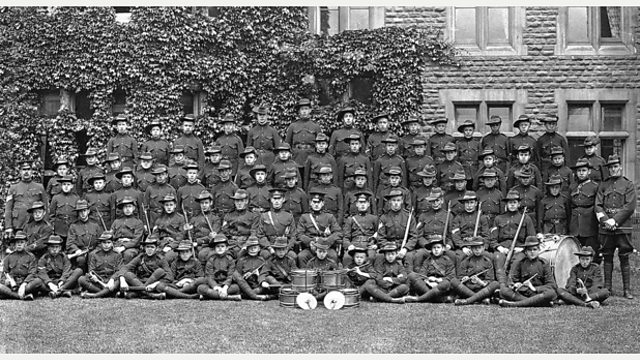Monmouth Boys School: Angus Buchanan the Blind VC
During 1914 Momouth School began to feel the effects of the War. Most of the Masters enlisted or were called up, at one time the senior boys had to teach the juniors.
Seventy-six former Monmouth School pupils were killed in WW1. Dr Steven Connors, Headmaster, pays tribute to the young officers who served and those that lost their lives. Dr Connor also provides an insight into the effects of the Great War on Monmouth School between 1914 and 1918.
One of the myths surrounding WW1 is that the upper classes and highly educated got off lightly. However, it could be said that the more exclusive your education, the more likely you were to die, as the chances of young public school officers surviving during the First World War were scant. It was the job of Junior Officers to lead the way over the top and expose themselves to the greatest danger as an example to their men. Some 12% of the British army's ordinary soldiers were killed during the war, compared with 17% of its officers. One of these officers was Wales International rugby player, Horace Wyndham Thomas. He entered Monmouth School on a scholarship from Bridgend County School and was killed in The Somme.
Another young officer who survived the war was Angus Buchanan; an inspiration in both war and peace. He lost his sight whilst saving two men in the First World War for which he earned the prestigious Victoria Cross. He received the award on the 8th November 1917, when thousands had gathered for the investiture of King George V of 127 recipients of gallantry medals and other honours. Each man was clapped as he approached the royal dais. However the loudest round of applause, from soldiers and civilians alike, was reserved for a uniformed officer and former pupil of Monmouth School, who was led to and from the dais by a chaperone who kept a firm grip on the now blind Angus Buchananβs left arm. Despite losing his eyesight in battle, he went on to study law and led an active professional life as a solicitor. At the time there were no legal books in braille so the books had to be read to him by somebody β which he then had to memorise.
A number of members of staff joined the forces: Mr Elstobm for example, became Captain in the Monmouthshire Regiment, whilst the French teacher, Monsieur Camous, joined the French Army . The Headmaster, Lionel James, threw himself into the townβs war effort. The OTC went on night marches and engaged in trench-digging and signalling exercises. Matches were played to raise money for the troops. The Schoolβs rifles and playing fields were given over to the National Training Volunteer Corps, a Great War equivalent of the ΒιΆΉΤΌΕΔ Guard.
In total, 76 Old Monmothians were killed in the First World War and they are remembered on the schools war memorial. At the unveiling, Angus Buchanan expressed βthe hope that the war memorial, a simple granite cross would never be a mere ornament, but always a true and lasting memory to those who gave their lives. β
The War had one beneficial effect in that it brought the school and town closer together. Masters began to play a part in town affairs, with Captain Elstob becoming a member of the Council and eventually Mayor of Monmouth.
Location: Monmouth School, Almshouse Street, Monmouth, NP25 3XP
Image courtesy of Monmoth school archives shows a band of smiling cadet soldiers, before the outbreak of war
Contributor: Dr Steven Connors, Headmaster, Monmouth School
Music: Monouth Boys School Choir
Duration:
This clip is from
Featured in...
![]()
Latest stories from across the UK—World War One At ΒιΆΉΤΌΕΔ
A selection of stories from At ΒιΆΉΤΌΕΔ's November release.
![]()
Video & Footage
Clips from programmes, WW1 footage & slideshows
![]()
ΒιΆΉΤΌΕΔ Radio Wales—World War One At ΒιΆΉΤΌΕΔ
Places in Wales that tell a story of World War One
![]()
ΒιΆΉΤΌΕΔ Front Life—World War One At ΒιΆΉΤΌΕΔ
Everyday life in the towns, villages and countryside
More clips from World War One At ΒιΆΉΤΌΕΔ
-
![]()
The loss of HMY Iolaire
Duration: 18:52
-
![]()
Scotland, Slamannan and the Argylls
Duration: 07:55
-
![]()
Scotland Museum of Edinburgh mourning dress
Duration: 06:17
-
![]()
Scotland Montrose 'GI Brides'
Duration: 06:41








